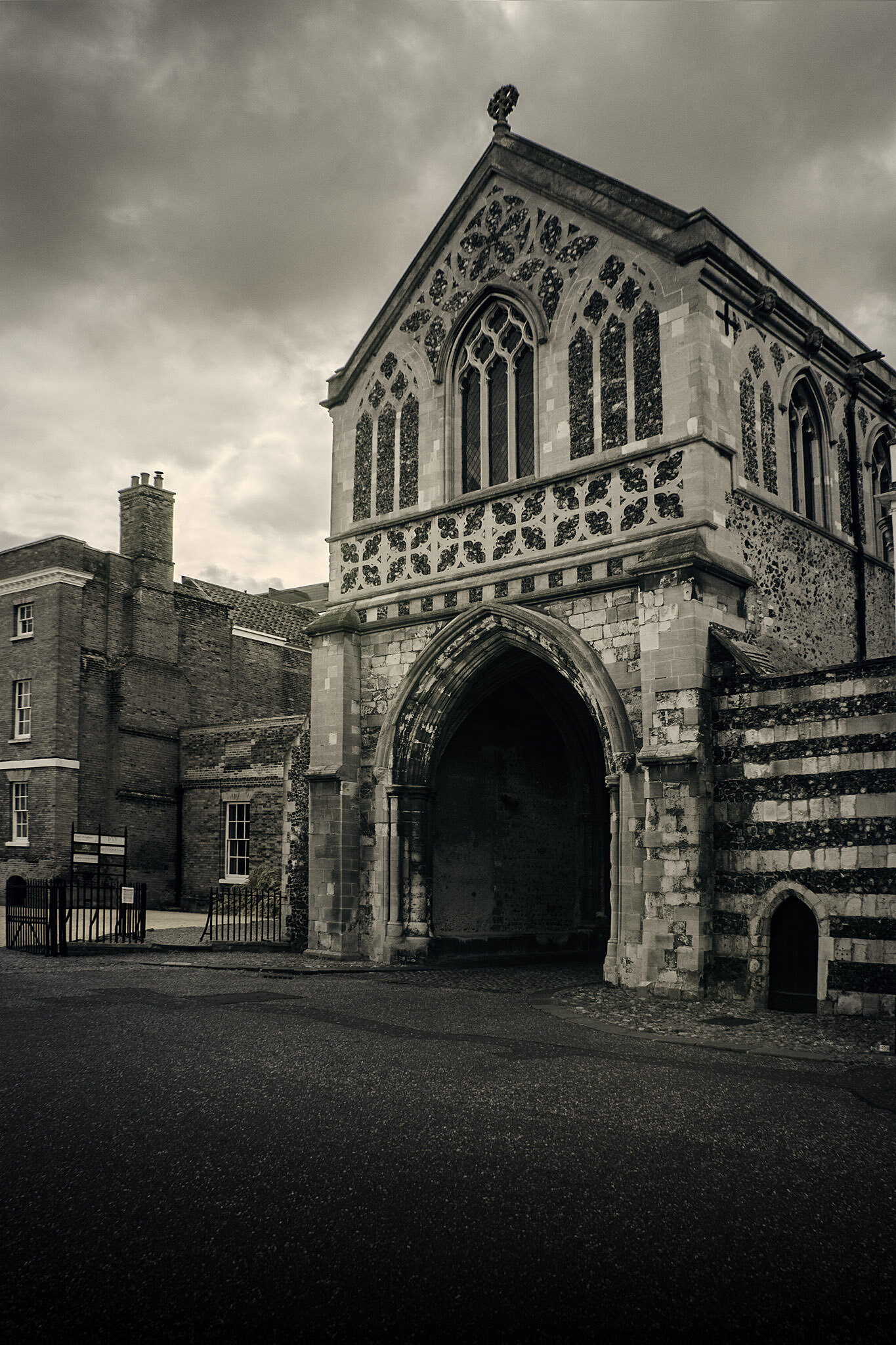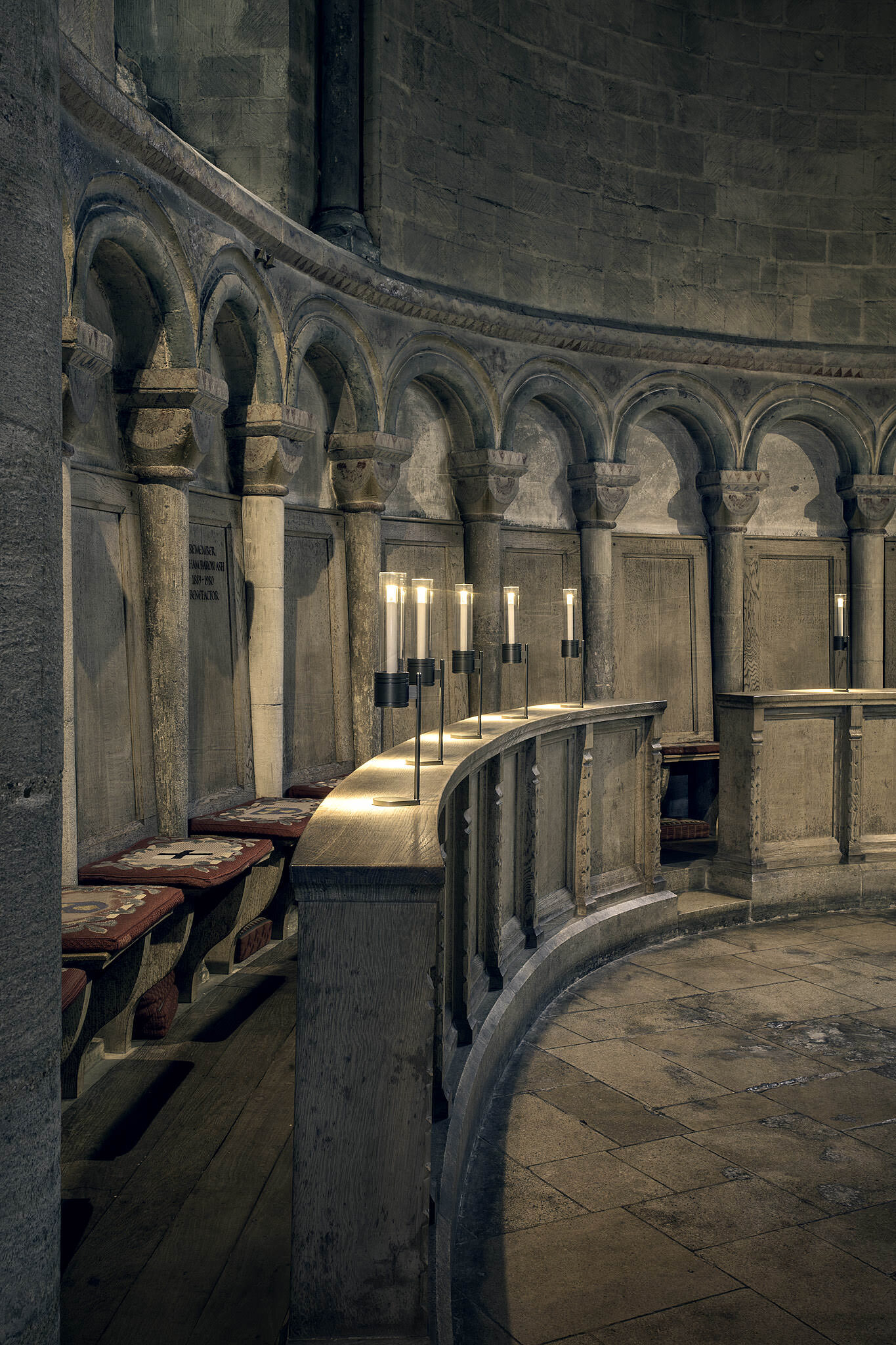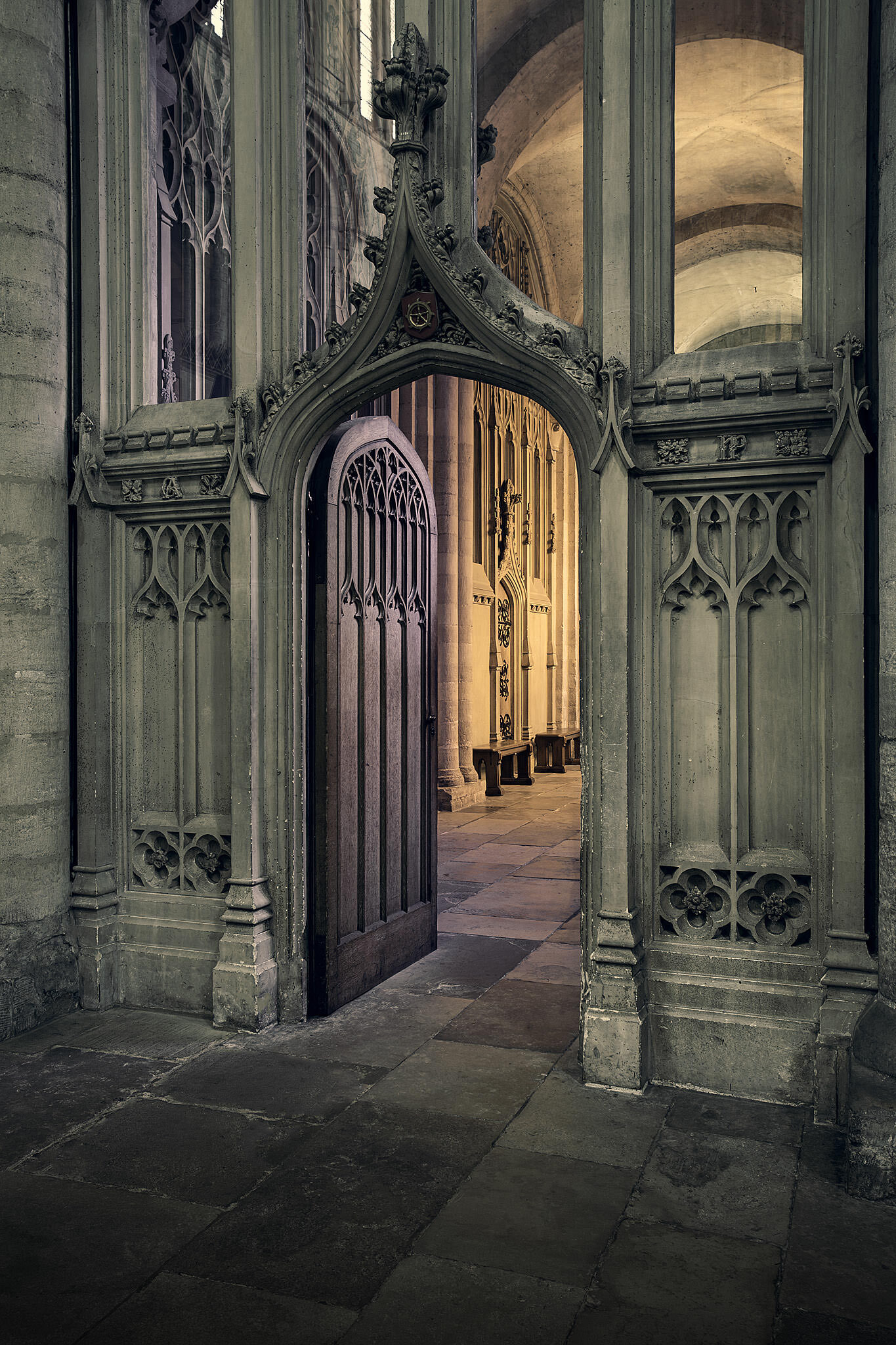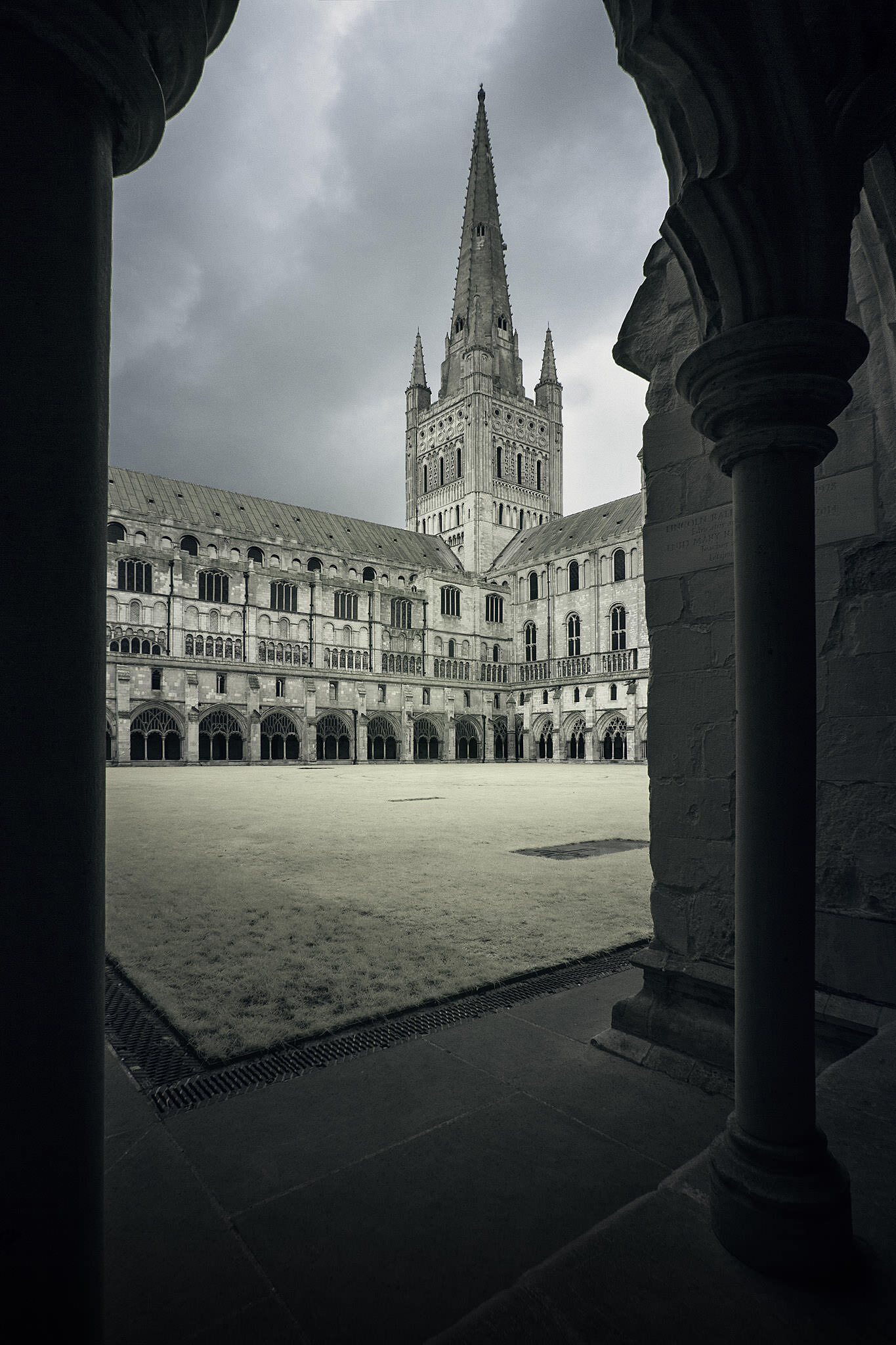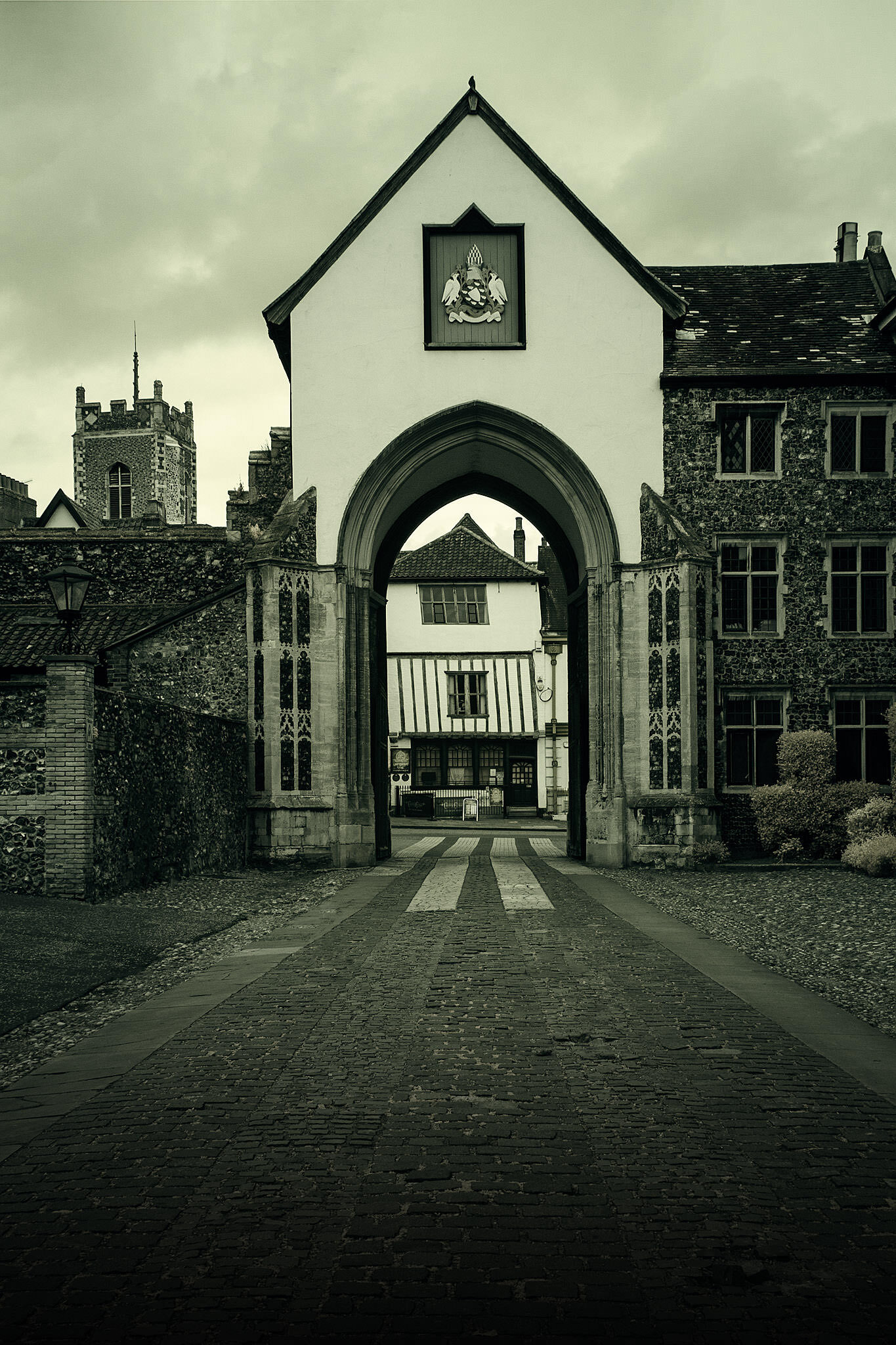Norwich Cathedral, Eastern England



English Cathedrals, in contrast with continental cathedrals, were served by communities of secular canons or priests. In England there were two parallel systems of monastic and secular cathedrals. The monastic cathedrals developed from ecclesiastical reforms of the 10th Century. By the 9th Century, monastic life in England been decimated by continuous Viking attacks. Monastic communities were revived in the 10th Century under King Edgar, and through the Abbots of Dunstan, Ethelwold and Oswald, who resurrected ancient monastic sites and converted cathedrals from secular colleges, to monastic communities. By the time of the Norman Conquest, there were monastic cathedrals at Canterbury, Winchester, Worcester and Sherborne. England ended up with an equal mix of monastic and secular cathedrals. Secular cathedrals were divided into prebends, and held by individual canons or prebendaries, their priests were allowed to marry until the 11th Century. Whereas, the Bishops, with monastic Cathedrals, were titular Abbots of their Cathedral Priories, and the endowments the Priory received were common property with the Cathedral.
The story of the Cathedral at Norwich begins with Herbert de Losinga, who was born in Normandy between 1050 and 1060. He was educated at the Monastery of Fecamp, in Normandy, and it was his father, Robert de Losinga, who travelled to England with William the Conqueror. Herbert became the royal chaplain to William the Conqueror, and was acquainted with his heir William Rufus. He was appointed as Abbot of Ramsey, but in 1091 he was offered a promotion when the Bishopric of Thetford, in Norfolk, fell vacant. He paid a large fee to obtain the position, and yet this in itself was a sin, for one to desire such a prestigious position. It was seen as the ecclesiastical sin of simony, meaning the buying or selling of a religious post or privilege. So, it is said that in order to clear his conscience, he travelled to Rome to seek forgiveness from the Pope. While he was there, he managed to have his Bishopric of Thetford transferred to the more prosperous, and rapidly advancing, City of Norwich. Now all he needed was a new Cathedral.
The old Anglo-Saxon part of the city of Norwich was known as Tombland. This was the original market area in Norwich, but the whole site was cleared in 1096 to provide enough space to build the Cathedral, and create an open area surrounding it. It was Bishop Herbert’s plan to not only build a Cathedral, but also a Benedictine Priory to accommodate sixty monks. A canal was dug from Pull’s Ferry to the lower close, to speed up the transport of stone and other building materials. The development of the site involved the demolition of the houses of Saxon inhabitants, which as you can imagine caused anger with the local residents, who simply saw the Norman oppressors taking advantage once again. One of the buildings destroyed was the palace of the Saxon Earl, Gyrth Godwinsson. The homes of the poor near the river were also torn down. These were just obstacles to the Normans and stood in their way, but the local Anglo-Saxon people were watching their community, heritage and identity being torn apart.
The first stone of the Cathedral was laid by Bishop Herbert in 1096. Within five years, the choir was open to provide services. When Bishop Herbert died in 1119, he was buried in front of the altar of his Cathedral, which wasn’t completed until 1145. Bishop Herbert’s Cathedral was not only the largest building in all of East Anglia, it was also a Romanesque work of art.
The entrance doors of Norwich Cathedral have been left unaltered and as they were originally intended to appear. The stone work, dating from the 12th century, with a plain semi-circular archway and simple mouldings, show their Romanesque design.
The enclosed precinct at Norwich covered an area of 42 acres. All monastic communities were separated to come extent from the outside world, and the wall surrounded the Cathedral's close, was both symbolic and protective. Some of the walls and gateways, which marked the boundary of the monastic settlement, are still visible. Bounded by the River Wensum, the Cathedral's lands were a small town, within a city.
The properties owned by Norwich Cathedral were extensive. There were 5 dependant monastic cells at St. Leonards, Lynn, Yarmouth, Aldeby and Hoxne. A further 16 manors, lands rents, mills timber and tolls, all created income for the Cathedral. Within Norwich, half of the city’s churches owed their tythe to the Cathedral. Although children were initially forbidden from the monasteries, by 1215 a school for boys was founded in the precinct. The school was associated with the almonry, and had 13 resident pupils at the time of monastery was dissolved in 1538.
In 1272, during the last year of the reign of Henry III, the Cathedral was burning. This was during the riots which had broken out between the towns people of Norwich, and the servants and monks of the Priory. Although the original Cathedral had suffered from fire at this time, it still retains its original Norman layout. The nave is entirely Norman in construction, with the exception of its vaulted roof, which was rebuilt in stone. The nave is 250 feet in length, and comprises 14 bays, from the west door to the intersection of the transepts. This is said to be the longest in England, although St. Albans might argue that point.
After the riots of 1272, the King’s edict of 1275 imposed a fine of 3,000 marks, to be paid by the city to the monastery, ensuring that repairs could be speedily carried out. The Ethelbert Gate, with chapel above, was rebuilt in 1316 and paid for by the people of Norwich, not because they wanted to build a gate, but because they had been ordered to rebuild the gate. This flamboyant gate, in its avant-garde way, was a brave design at the time of its creation. One might wonder, if the towns people had deliberately built this gate in a way that would upset the priory, since they had been forced to pay for it. Were they showing off in what they could afford to create, or were they deliberately and subtlety making a point? It’s difficult to tell 800 years later, and there are no records of what the Bishop or Prior thought of the gate, but it is clear that it didn’t exactly fit in with the simple Romanesque and sombre design of the Cathedral.
In one sense, Norwich Cathedral Priory was an establishment that extracted money from the countryside, and spent it in the city. The net income of the Priory, in 1300, is estimated to have been £2,500. While 30% of this may have been used on the Priory at Norwich, the rest would have made its way to the Cathedral's coffers. The Priory would have employed around 150 servants, making the priory the largest employer in Norwich. That is before we take into account, the hundreds of years where people were employed in building work at the Cathedral. The Cathedral's close, or precinct, would have housed both monastic and lay populations. Its layout was designed to cater for both communities, while keeping them separate. At Norwich, the foundation of the Cathedral’s Priory had always been intended to house sixty monks, but the records of 1348, record sixty-seven living there. After the plague hit Norwich in 1349, their numbers were halved.
The Reliquary Arch, in Norwich Cathedral, is unique. It is possible that it was felt there was a greater need to keep their relics safe after the riots of 1272. The arch was built to house relics, such as bones of a saint, fragments of clothing or special items. The room is reached by a steep stone staircase, and now houses the Cathedral’s Treasury. Unfortunately, it was closed when I was there, but it is worth knowing that the ceiling contains medieval paintings.
In the 13th and 14th Centuries, it has been estimated from the priory records, that the Cathedral's close, or precinct, had around 270 people living there, while only 50-60 would have been monks. The rest would have comprised lay brothers, visitors, workmen, men from manorial farms, boys in the school, the poor visiting the almonry, and some 150 staff members. The staff members comprised of 51 in the Prior’s household, the Cellarer employing 26, the Sacrist 25, the Almoner 15, the Chamberlain 15, the Infirmarer 2, the Hostiliar 4, the Precentor 1, the Refectorer 4, the Pittance 1, and the Gardener 2. All their staff or servants would have been secular, and may have lived in the precinct with their families. Although we know little of who they were, one document tells us, that one of these men was Gerard, who took sanctuary in the Cathedral after fleeing from the tyranny of his Lord. So, for the rest of his life, he remained a servant of the church. In the later middle ages, we also know that the monastery's tailor and barber, lived with their wives in the precinct.
The Nave’s ceiling, is the work of Bishop Walter Le Hart (1446-1472). The roof suffered damage when the spire was struck by lightning in 1463. The naves ceiling was recreated in stone. There are 255 carved stone medieval bosses, which sit above the Cathedral’s Nave and Choir. They tell the story of the old and new testament, and are a snapshot of medieval 15th Century life. However, to see them in detail, you either need to buy the book or bring binoculars, as the ceiling is 69 feet high.
The design of the new stone roof, was the work of stonemason Reginald Ely, who had previously worked on King's College Chapel, in Cambridge. Although he designed it, he did not oversee the work. This job was given to Norwich’s Master Mason, Robert Everard, who completed the task from the designs. At the time of the reformation, the bosses were white washed over, as destroying them would have compromised the integrity of the roof. The white was removed in 1870, and they were repainted in the 1930’s.
The Choir stalls are arranged on either side, and are 62 in number, for the Prior, sub-Prior and sixty monks. Their carvings and details mainly date from the middle of the 15th Century. Unfortunately, their Misericords are not on display, as the seats are down and covered with cushions, but what is on display are 15th Century carved elbow rests, which range from Bishop’s heads, angels, men with shields, old men with beards, and coats of arms.
In 1847, the Despenser Retable was discovered, in a room above one of the chapels inside Norwich cathedral. It consists of five scenes from the Passion, and should not have survived the reformation. It is its very shape that allowed for its survival, as turned upside-down it quickly becomes a tabletop, and it is likely that someone had the forethought to do so in the 16th Century, when all religious icons were all ordered to be destroyed. More than ninety percent of English medieval religious painting was destroyed at the time of the reformation. This altarpiece once sat behind an altar, and does so once again. The retable dates from the 14th Century, and is thought to have been created in Norwich.
The Erpingham window contains medieval glass, and includes examples from the Norwich School of glass painting. The borders of the glass are made up of medieval fragments. The windows only connection to Thomas Erpingham, is that it once contained a stained-glass image of him and his two wives. The window’s glass is a collage, made up of fragments of medieval glass that were put together in 1963, from various pieces of medieval glass that survived.
The Erpingham Gate was built to celebrate the victory at the Battle of Agincourt in 1415, in which Sir Thomas Erpingham was the commander of the archers. This maybe what he is most famous for, but he also was a benefactor of Norwich. He had been a retainer in the service of John of Gaunt, Duke of Lancaster and father of Henry IV, and helped to re-establish order in Norfolk during the Peasant’s Revolt. He fought for Richard II against the Scots, and for John of Gaunt, in Castile and Leon. He then aligned himself with Henry Bolingbroke, later Henry IV, and even followed him abroad during his exile. He was involved in deposing Richard II, and guarded him in the Tower. He became Chamberlain to Henry IV, and was given lands in Norfolk and Suffolk. Most of Henry IV’s councillors were dismissed by Henry V, but Erpingham remained, and was made royal steward. Thomas Erpingham gave the gate to the Cathedral, and it is therefore named after him. A statue of him sits in the niche facing the city. This gate is just in front of the west entrance to the Cathedral.
The original Norman cloisters were probably built in wood, and were destroyed during the 1272 riots, between the town and the monastery. There doesn’t seem to have been a rush to rebuild them, as the work took 150 years to complete. The work is also thought to have slowed due to the plague in 1349. During this 150 years, while they were being rebuilt, the style of Gothic architecture changed in England and, of course, wanting to keep up with the latest fashions, the monastery adjusted their designs over the course of the building project.
Work commenced on the new cloisters in 1297. The changing architectural styles during their rebuilding has left us with a display of English Gothic design. The reconstruction of the cloisters at Norwich was well documented, and has helped historians today date the different styles used. The east cloister walk is the oldest, and contains geometric work dating from (1299-1314). The Decorated Gothic tracery of the south and west cloisters date from 1314-1356, and the Perpendicular style of the north cloister dates from 1382-1400. The cloisters as a whole are like a catalogue of English Gothic style.
The cloisters were always one of the most active parts of the monastery. They integrated four ranges of buildings, and connected them all through covered walkways, which helped to keep the monks out of the rain. They were also used as places for work and study. The Priors Door leads from the cloister to the church. The door itself is highly decorated, and one of the finest sculptured doorways in England. The arch is of deep multiple mouldings. The work dates from the 13th Century. This would have been the main door for the monks to enter the church from the monastery.
The sculpture of the Priors Door was created to compliment the adjoining roof bosses. The door has been described as one of the finest examples of English carving of its time, and is thought to be contemporary with the building of the east walk. A plaster cast of the Priors Door was made in 1851 for the Great Exhibition, and is now housed in the V&A museum in London.
The roof bosses in the cloister are a mixture of secular and religious carvings. They are made up of foliage, mythical beasts, folklore, and even the semi-rare Greenman makes an appearance. The keystones hold the ribs in place and are decorated with these fantastic carved bosses dating from 1330-1430. These bosses are some of the earliest of their kind. They were carved from stone, imported from Caen, in Normandy, and it took two weeks to carve each one. Once completed, they were painted with vivid colours. The completed cloister comprises 49 bays, with the vaulting of each bay having 8 bosses, totalling 394 bosses. A similar constructions used in the roof of the Nave, so if you include them all, then over 1,000 medieval carved bosses survive at Norwich Cathedral.
At the western end of the south walk, are two lavatoriums which have survived. It was here that the monks washing before entering the refectory for meals. They also washed again after every meal. An additional rite was carried out weekly at the lavatorium, the mandatum fratrum, the ritual of washing of the feet. This was interpreted as a spiritual cleansing of the soul, but I bet it also made it easier for them all living in the dormitory together as well. The lavatoriums were originally built in the 1430’s, and restored in the 20th Century. The statues were added at this time. One set is of George V and Queen Mary, while the other statues are of George VI and his Queen, Elizabeth.
The book cupboards are built into the thickness of the outer wall. They can be seen in the east and south cloister. They appear either singly, or in groups of two, three or four per bay. Two, in the east walk, retain wooden doors. A further 17 have been identified, which have been filled in. The identification of at least twenty book cupboards, confirms that the cloister was used for reading and study.
There is one story that I feel should be included, although it is somewhat hard to understand, as well as to do justice to, when writing it. It is the story of William of Norwich. He was born on the 2nd of February 1132, and whatever the truth of his circumstances, his story is one of tragedy, and on a few different levels. While it is hard to tell the truth from the lies in this story, it is even harder to talk about the atrocities that were committed, because so many of them still affect the societies we live in today.
When William was just 12 years old, in 1144, he was apprenticed to a tanner in Norwich. It is said that due to his trade, he regularly came into contact with the Jewish community, of which there were thought to be a couple hundred Jews, living in Norwich at this time. In the 12th Century, the small number of Jews in England would have been the only non-Christians. However, they were the wards of the King, at this time King Henry II. This status allowed them freedom to use the King’s highways, they were exempt from tolls, and were allowed to hold land directly from the King. There is no doubt however that these privileges were resented, by the people of most towns, they were seen as the ‘other'. So, when tragedy stuck the young William, they were an easy scapegoat.
While we have a lot of details for this story, as it was written down in 7 parts, by a monk named Thomas of Monmouth, who lived at Norwich Priory, we have little reason to believe much of what he wrote. It is easy to believe that he believed what he wrote though, as it is all written in a very matter of fact manner. So, what happened to William? Well, the truth is we don’t know. All we do know, is that the boy, William, was found dead in the woods near the city. It was said that he had been tortured. Thomas the monk offers us "proof" that it was the Jews who had killed him, simply because 'no Christian could do such a thing'. The crime was seen as horrific, even in an age of many horrors. The murder of a child was a recognised evil, and many appalling stories were created to blame the Jewish community for this murder. Young Williams body was brought back to Norwich, and he was allowed to be buried in the Cathedral's cemetery. In Thomas of Monmouth’s writings, miracles began to occur, and little William's body was later moved into the Cathedral, where it was proclaimed, he was a Saint. After all, Norwich didn’t have one yet. In Thomas’s writings, he aims to prove to his fellow monks, and to the reader, that little William was indeed a Saint.
Not only did this story stir up antisemitism amongst the Christian population of Norwich, it was copied. A young boy named Hugh, died in Lincoln in 1255, and the Jews were blamed again. Rumours spread that the Jews were abusers and killers of Christian children. We have a child murder in Gloucester in 1168, and in Bury St Edmunds in 1181, both again blamed on the Jews. Even Geoffrey Chaucer has his Prioress, in the Canterbury Tales, recount the hideous tale, of a Jew slitting the throat of a singing schoolboy. The stories became more hair-raising as time when on, but of all the stories against the Jews, that of child murder was most heinous. This same story has been used throughout the centuries, against entire Jewish communities. And it all started with the monk, Thomas of Monmouth, who saw it as his life’s ambition, to prove that little William was actually a Saint. In doing so, he scapegoated an entire community, which lead to appalling outcomes, even before the Jews were expelled from England in 1290.
In 2004, a discovery was made in the centre of Norwich, where the remains of 17 bodies were found, at the bottom of a medieval well. At first it was thought that they may have been victims of the plague, but between DNA analysis, and carbon dating, it was discovered that the skeletons dated back to the 12th or 13th Centuries. Seven of the skeletons were successfully tested, and five of them had DNA sequencing which suggested they were likely to be members of a single Jewish family. The scientists working on the remains, are certain these were members of the Jewish Community in Norwich, and I don’t think it is too far of ta leap to hold Thomas of Monmouth accountable, in part, for their demise. They didn’t just jump into this well - they were murdered. Of the 17 skeletons discovered, eleven were those of children, aged between 2 and 15. The remaining six, were adult men and women, all thrown in head first. I don’t know of another example, which can better exhibit the horrors that were suffered by the Jewish community in 12th Century England.



